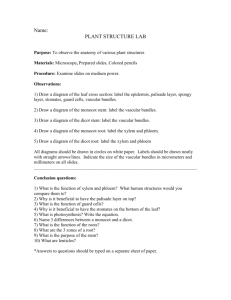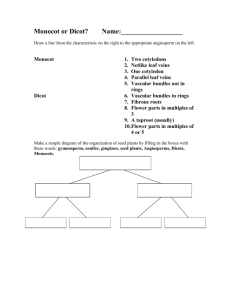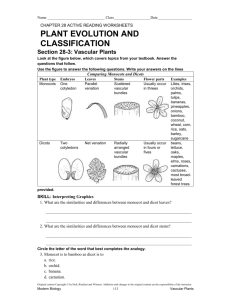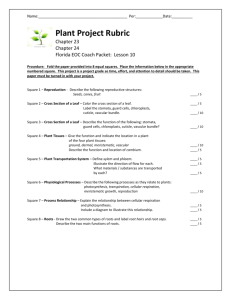LAB - Plant Tissues & Organs
advertisement
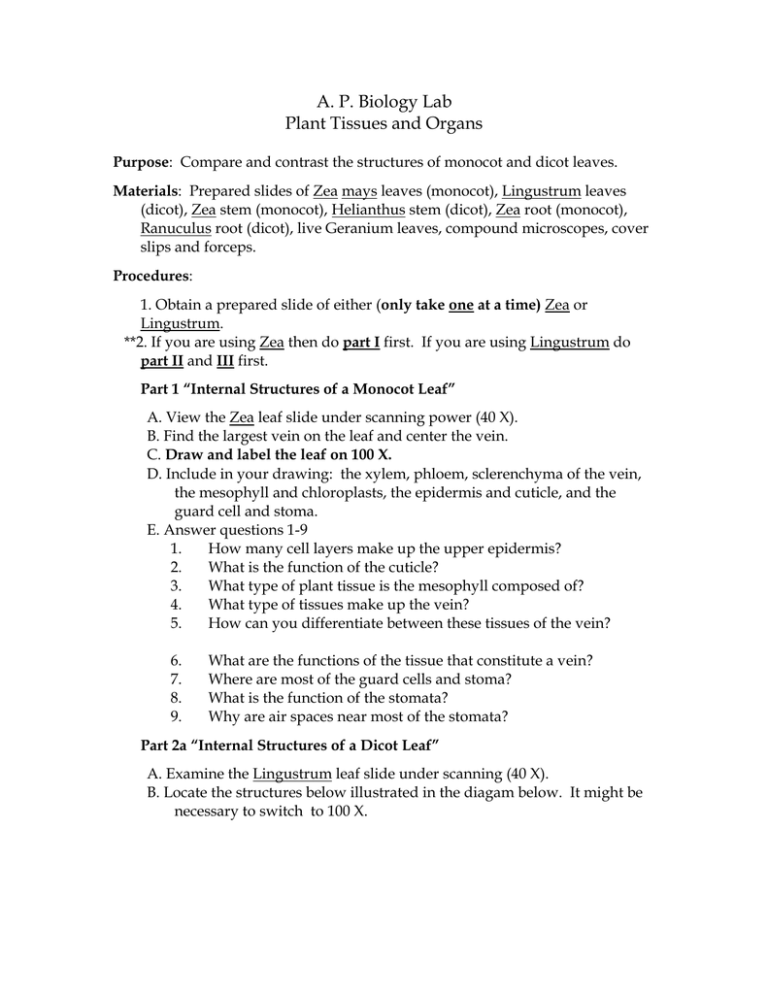
A. P. Biology Lab Plant Tissues and Organs Purpose: Compare and contrast the structures of monocot and dicot leaves. Materials: Prepared slides of Zea mays leaves (monocot), Lingustrum leaves (dicot), Zea stem (monocot), Helianthus stem (dicot), Zea root (monocot), Ranuculus root (dicot), live Geranium leaves, compound microscopes, cover slips and forceps. Procedures: 1. Obtain a prepared slide of either (only take one at a time) Zea or Lingustrum. **2. If you are using Zea then do part I first. If you are using Lingustrum do part II and III first. Part 1 “Internal Structures of a Monocot Leaf” A. View the Zea leaf slide under scanning power (40 X). B. Find the largest vein on the leaf and center the vein. C. Draw and label the leaf on 100 X. D. Include in your drawing: the xylem, phloem, sclerenchyma of the vein, the mesophyll and chloroplasts, the epidermis and cuticle, and the guard cell and stoma. E. Answer questions 1-9 1. How many cell layers make up the upper epidermis? 2. What is the function of the cuticle? 3. What type of plant tissue is the mesophyll composed of? 4. What type of tissues make up the vein? 5. How can you differentiate between these tissues of the vein? 6. 7. 8. 9. What are the functions of the tissue that constitute a vein? Where are most of the guard cells and stoma? What is the function of the stomata? Why are air spaces near most of the stomata? Part 2a “Internal Structures of a Dicot Leaf” A. Examine the Lingustrum leaf slide under scanning (40 X). B. Locate the structures below illustrated in the diagam below. It might be necessary to switch to 100 X. C. While looking at the image under your microscope, answer questions 111. 1. How thick (how many cell layers) is the palisade layer? 2. What structures are present in the palisades cells? 3. Why are these found in this layer? 4. If you were to travel down the xylem of the leaf where do you think you would end up? 5. What color is the leaf phloem? This might help you answer question # 5. 6. What is the function of the phloem of the leaf? 7. What color is the xylem of the leaf? 8. What is the function of the xylem of the leaf? 9. How does the Lingustrum (Dicot) differ from the Zea (monocot) leaf? 10. Where are most of the stomates found in the dicot leaf? Why? 11. Why are tendrils, succulents and needles called modified leaves? Part 2b “The Stomata” A.Obtain a geranium leaf and using forceps, peal a small amount of epidermis from the lower surface of the leaf. B. It should be clear and thin, if it is green it is too thick. C.Place this piece of epidermis on a slide and make a wet mount. D. Examine under the microscope and draw it on at least 400x. Part 3 The Monocot stem A. Examine the slide under 40 X first. B. Locate the structures below. C. Draw and label (xylem, phloem, pith, epidermis,bundle sheath cells (sclerenchyma), a pie section of the stem on 100 x. D. Answer questions 1-7 1. What is the function of the epidermis? 2. Do the epidermal cells have a consistent shape? Describe this shape. 3. What type of tissue is the pith composed of? 4. Knowing the type of tissue the pith is composed of what would you expect its function to be? 5. How are the vascular bundles arranged in the stem? 6. Where are most of the vascular bundles found? Why? 7. Why are these bundles referred to as vascular bundles? Part 4 A close up of the monocot stem vascular bundle A. Now switch to 400 X and move a vascular bundle to the center of view. B. Use the diagram on the top of the next page and the slide to answer questions.1-10. C. Answer questions 1-10 1. What is the function of the xylem? 2. Describe the shape of the xylem vessels. 3. What characteristic of the xylem suggests it might also help support the plant? 4. What is the function of the phloem? 5. What is the common term for the material the flows through the phloem? 6. 7. 8. 9. 10. How can you differentiate between xylem and phloem? What type of tissue surrounds the vascular bundle? What is the function of this tissue? What color is the xylem in most of the vascular bundles? The phloem? Do you think this might aid in identification of these tissues? Part 5 The dicot stem A. Now examine a prepared slide of a dicot stem under the microscope and locate the following structures. B. While on 100 X answer questions 1 and 2 C. Switch to 400 X and locate a vascular bundle, then answer questions 3 and 4. Low Magnification High Magnification 1. 2. 3. 4. How are the vascular bundles arranged in the stem of the dicot? Why? List any other differences between the dicot and monocot stem. Just outside the xylem is the cambium, how does it differ from the xylem? Just outside the cambium is the phloem, how does it differ from the cambium? Part 6 Monocot Root A. Examine a prepared slide of a monocot root under the microscope. B. Answer questions 1-5. 1. In the root, which type of tissue is most common? 2. How does this relate to the function of the root? 3. What is the function of the endodermis? 4. Describe the arrangement of the xylem in the monocot root. 5. How does the monocot root differ from the monocot stem? Part 7 Dicot Root A. Examine a prepared slide of a dicot root under the microscope and locate the structures labeled below. B. Draw and label the dicot root. C. Answer quesions 1-8. 1. What is the function of the epidermis? 2. What is the function of the xylem? 3. What is the function of the phloem? 4. The cells of the cortex store starch. What aspects of their structure illustrates the principle "form follows function". 5. List several roots we include in our diet. (list at least 3) 6. Why is the area inside the endodermis referred to as the vascular cylinder? 7. How does the dicot root differ from the monocot root? 8. What are the dark rounded bodies inside the phloem cells? Conclusion - Address the concept “form follows function”
